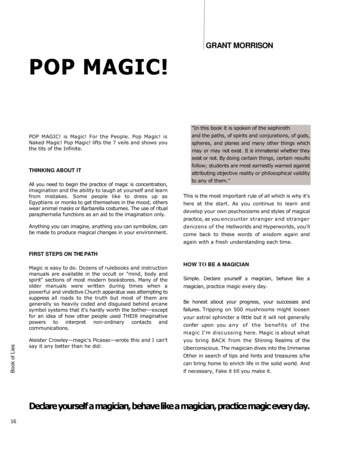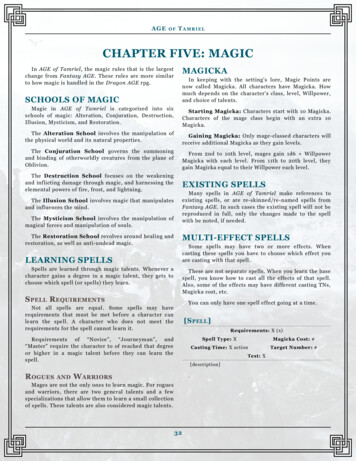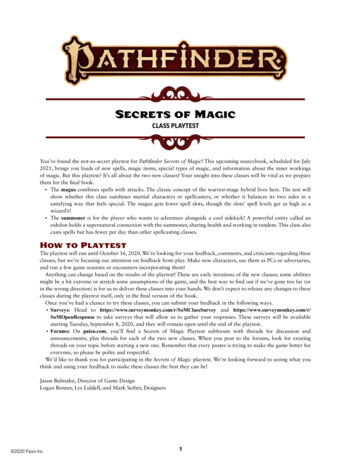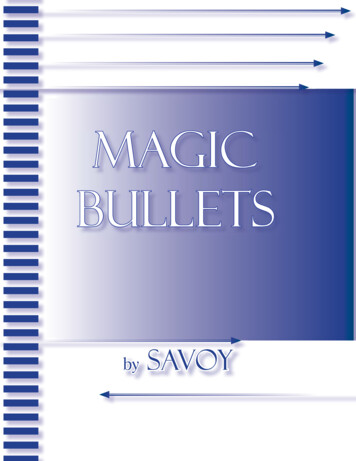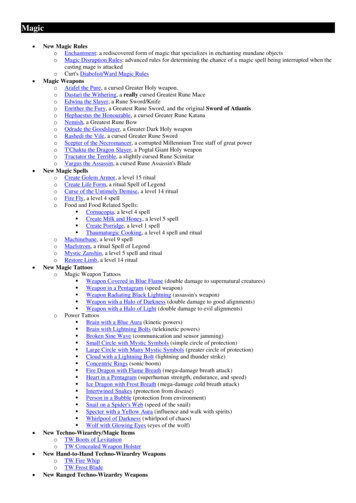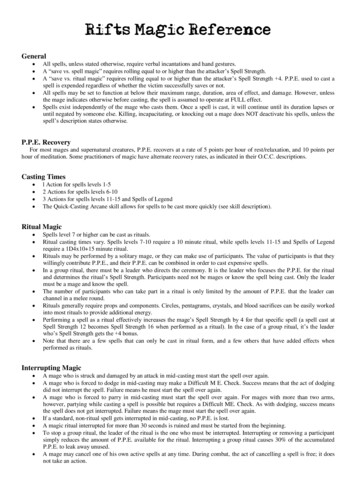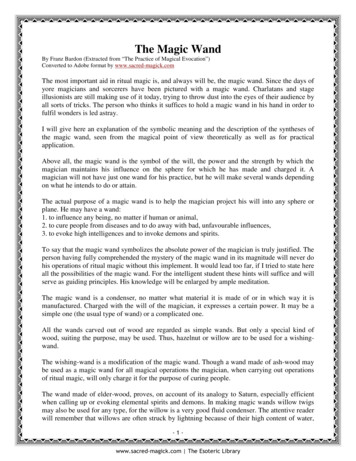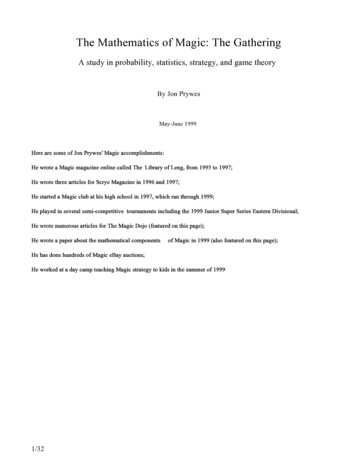
Transcription
The Mathematics of Magic: The GatheringA study in probability, statistics, strategy, and game theoryBy Jon PrywesMay-June 1999Here are some of Jon Prywes’ Magic accomplishments:He wrote a Magic magazine online called The Library of Leng, from 1995 to 1997;He wrote three articles for Scrye Magazine in 1996 and 1997;He started a Magic club at his high school in 1997, which ran through 1999;He played in several semi-competitive tournaments including the 1999 Junior Super Series Eastern Divisional;He wrote numerous articles for The Magic Dojo (featured on this page);He wrote a paper about the mathematical componentsof Magic in 1999 (also featured on this page);He has done hundreds of Magic eBay auctions;He worked at a day camp teaching Magic strategy to kids in the summer of 19991/32
Table of ContentsIntroduction to Magic: The GatheringA Mathematical Introduction. 3A Description of the Game .4A Sample Game .6Why Experience Counts.7Two-Person Game TheoryWhat Does It Mean?.9The Basic Concepts.10Two- Person Game Theory and Magic: The Gathering .12ProbabilityProbability and Magic: The Gathering .15Shuffling and Randomization .1 6Drawing Cards From a Deck . 17The Average Game .2Chance Versus Skill .3DeckbuildingDeckbuilding and Magic: The Gathering .5Deck Archetypes and Deck Strategy .6Deck Comparison and Winning Ratios .7Card Efficiency and Resource Management .10The Big GameProbability, Statistics, Game Theory, and Magic .11Math and the Average Player . 12Personal Applications . 142/32
Introduction to Magic: The GatheringA Mathematical IntroductionMagic: The Gathering is a game which some take seriously, and others lightly. Many understand it, even more do not.Some play it nonstop and others never see the point. Persona lly, I think it is a great game. Only those who actually playthe game can truly understand how wonderful it is. Most people who write it off as pointless do not see the mechanics ofthe game t hat make it simple, yet comp lex. In its five years of existence, the crowd that Magic has drawn can alone showhow great the game really is. On the weekend of May 1 and 2 I traveled with som e friends to Pro Tour: New York inSecaucus, New Jersey. Hundreds of people were gathered inside the Meadowlands Exposition Center just to play thegame they love. The Pro Tour is no day in the park; it is a great competition for the mind.Zev Gurwitz, a junior at Scarsdale High School, along with my self, had both qualified for the Junior Super Series event.Sixty-four players age seventeen and unde r qualify for the JSS at challenge tourna ments held during the winter. We hadplaytested for this tournament a fairly lengthy amount, yet I was still skeptical. As it turned out, I went 1-3 and droppedout. Zev went 0-3 and dropped. A record of at least four wins was necessary to m ake the top eight, in order to play atthe JSS Championships where 250,000 in scholarship money is awarded. We tried, but what was it that kept us fromwinning? What is it that keeps every Magic player from winning all the time? What keeps even the most skilled of playersat bay from winning every single ga me? It is a word called chance.Chance is what makes Magic different from many other cla ssic games. When one plays Chess, he gets to see all thepieces. Both players have eight pawns and eight other pieces, either white or black. Every piece moved is publicinformation, and nothing is held secret. Chess is ruled by complete skill. Nothing random can possibly happen. Magic,on the other hand, adds a new element. Not only are each person s playing materials often different or varied (thedecks), but random ness exists in this game. One starts the ga me by random izing his deck of sixty or m ore cards, thendrawing seven. He will definitely not draw the same seven cards in every opening hand! Variety is what makes this gamedifferent than Chess. There are two elements of variety involved: Deck construction and random card draws.Deck construction is part of what governs this elem ent of variety. The card draws are simply a result of the deckconstruction, as well as any cards played during the game which may alter the contents of what is remaining in the deck(for example, removing cards from the deck). The Duelists Convocation International (DCI) is the authority governingsanctioned tournaments. Although many players do not part icipate in tournaments, the DCI s deckbuilding guidelinesprovide for a fair game.Some cards were printed before the research and development team realized they were overpowered. Hence, the cards arebanned from deck construction. Some cards are only restricted , meaning only one is allowed in a deck. Any card that isnot banned or restricted is allowed up to four copies per deck. A player has to think, how m any copies of a card do Iwant in m y deck? One, two, three, or four? If he puts four copies in, he is likely to draw one very soon. If he only usesone, his chances of drawing it are slim. Maybe having multiple copies is redundant and that is the reason for using fewer.If he uses three copies of a card, then what will be his chan ces of drawing one by turn six? Probability pokes its nose upinto the gam e now.In Chess, there is no probability, other than thinking about the number of possible moves. However, a player s play styleis more likely to govern how he plays the game of Chess th an probability will. For all intents and purposes, there is noprobability in Chess. Probability goes hand in hand with chan ce and random events. It is the chance that an event willoccur, or not occur. Will your adversary dr aw the card he needs to win the game this turn? Next turn? Within five turns?Calculating the chances can help a player decide whether to play defensively and anticipate the other person drawingtheir win card, or play aggressively and assume that the card will not be drawn by the other player.Some of the other math involved in the game is less obviou s. The chance versus skill question is a very hot topicamong high-level players. How much of playing a given deck is based on skill, and how much on chance? The obvioussolution would be to take a fairly inexperienced player and give him one deck, and give an experienced player the other.3/32
The experienced player will win with either deck if there is complete skill involved. If the deck is straightforward to thepoint that there are no decisions to be m ade, and it beats the other deck alm ost autom atically, then it is possible theexpert will lose games. In Magic, though, there are always at least some thoughtful decisions to make. The chance ofgetting paired against a superior deck in a tournament does not mean an automatic loss. If your skill is lower to that ofthe superior deck your chances may be slim, but if your skill is higher than your chances become much greater.So then, what constitutes a superior deck? What deckbuilding techniques are necessary for one to make a deck that winsmore often than a deck which is not as good? How does on e determine which card selections will guarantee a flawlessroad to victory? Questions like these are what every player mu st try to answer when attem pting to create the perfectdeck. Of course, I will aim to prove that the perfect deck does not exist. Laws of game theory are an invaluable aid inproving this. While game theory is a very conceptual science, its laws very well do apply to games such as Magic. Whileknowledge of these laws will not make one a Pro Tour Player, they can help one who is trying to understand the gamehave an easier time making decisions. Game theory is sim ply a series of laws regulating how one goes about makingdecisions in a situation. A game in game theory is not ne cessarily always a game as defined in common talk, but gametheory certainly has many game applications.Through the laws of probability and game theory, along with st atistical analysis and actual experiments, I will be workingon com ing up with conclusions that can take these laws and correlate them to the gam e of Magic. First and forem ost, Iwill be explaining the basic concepts of game, in order for the reader who is unacquainted with Magic to familiarizehimself with these terms. In describing the game, I will a ttempt not to reiterate the entire rulebook, though I willsummarize the basics of how the game is played. Upon comp letion of these details, I will begin my outline of gametheory and begin on relating the math and game theory toits Magic applications. I will provide profiles of many of thepeople who I consult with as part of my project. I will be discussing a survey I conducted in order to determine howmuch math Magic players recognize as part of the game. This entire report will follow closely the outline given in myproject description.A Description of the GameThe object of Magic is simple. You start with 20 life points, and when they are reduced to 0, the game is over and theother person wins. You and another person both have a deck of sixty or more Magic cards, which are used in playing thegame. The cards can be from a variety of different sets, with ( for the most part) no more than four of any one card. Theplayers alternate in taking turns. Each turn is a sequence of events that involve drawing a card, putting cards into play,attacking the other player (using cards that repres ent creatures) and then discarding if necessary.The basic resource in Magic is called mana. Mana comes from a Polynesian word meaning energy. Mana let you bringcertain cards into play, and use abilities on cards already in play. Some cards require more mana to use than others do.There are five different colors of mana in the game, each representing a separate force. The forces represented are typicalof an adventure gaming genre: White mana represents the po wers of good. Blue mana is for the powers of the mind.Black mana is for the powers of evil. Red mana is for the po wers of destruction and chaos. Green mana is for the powersof nature and wildlife. Each color s theme is represented in the cards of that color.Thus a well-known adventure theme is presented in the cards, giving players something more than just a strategy game.It is a game with a them e, with the strategy hiding in the background for the m ore advanced players to take notice of. Inaddition, some cards do not have colors; these cards are ei ther land (which produce mana), or artifacts (which arecolorless and can be played with any kind of mana). All card s in the game are referred to as spells for game purposes,except for land. Lands are not spells and are not cast . They are simply placed into play. I will often use termsinterchangeably, however.Another concept that the player must understand is the word tap . To tap a card is to rotate it sideways, indicating thatits powers have been used. This can be used to represent an attacking creature, a used artifact, or a land drawn for mana.At the beginning of each turn you untap all your cards, so you effectively can use their powers once each turn (and/orduring your opponent s turn).4/32
A spell s casting cost is the amount of mana you need to use in order to play it. It is located in the top right corner ofthe card. If a card s casting cost is 2R, for instance, that means that you must spend one re d mana and 2 of any color toplay it. Casting cost will be referred to a lot so this is very important to understand. The colored portion is specific, andthe numbered portion is generic, and can be paid using any color mana.There are different types of cards in the game: Land, Artifacts, Creatures, Enchantm ents, Sorceries, and Instants. All cardscome in five different colors except for lands and artifacts. Lands are a special kind of card; you can play one each turn.Lands can be tapped for mana, which is used to play any of th e other kinds of cards. Artifacts are colorless, which meansyou can use any kind of mana to play them. They may let yo u do anything from draw cards to affect cards in play.Some artifacts are also creatures. Creatures can be used to do damage to your opponent (thus reducing his life totalfrom 20 to 0). However, if your oppone nt has creatures of his own out, he can use them to block yours. Enchantm entsare cards played on an existing card, which modify what the card does, usually. An example would be an EnchantCreature card, which would be played on a creature. It migh t make the creature weaker, or stronger. Some enchantmentsare not played on other cards, and have a global effect on the game. Sorceries and instants cause a one-time effect onthe gam e. Sorceries can only be played during your turn; instants can be played anytim e.At the beginning of the game each player shuffles his deck. The players roll a die or flip a coin to determine who chooseswho goes first, then each draws seven cards. The player who chooses to go first does not draw a card on his first turn. Thesequence of a turn is as follows:Untap phase: Untap all cards you control. This m eans to rotate them so they are all facing upward and not rotated(tapped).Upkeep phase: This is a maintenance phase. Some cards will make you do an effect during this phase, such as pay mana tokeep the card in play, for example.Draw phase: Draw a card.Main phase: You can do these things, in any order:a. Put one land into playb. Declare one attackc. Play spells. You can play spells before or after your attack, as well as both. Note that all cards (except for instants) canonly be played on your turn during the m ain phase.Discard phase: Discard down to seven cards.Cleanup phase: Any effect that lasts until end of turndestroy it, wears off as well.wears off now. Any damage on a creature, which does notThe attack works like this: You choose any untapped creatures yo u control that you have had in play at least one turn,and tap them . Your opponent either blocks them or takes dam age equal to their power. If he blocks, both creatures dealdamage to each other equal to their power. A creature has a pair of numbers in the bottom right corner. These are itspower and toughness. When a creature deals damage, it deals da mage equal to its power. When it receives, the damage isapplied to its toughness. If it takes damage equal to or grea ter than its toughness it will be buried. That means it will beplayed in a pile next to your draw pile called your discar d pile. For example, a Giant Spider has a power and toughness of2/4. It deals 2 dam age to a creature blocking or blocked by it , and if unblocked during an attack, deals 2 to the player itattacked. If it takes 4 damage during one turn, it will be placed in its controller s discard pile.5/32
The game gets a lot m ore com plex than this with the fram ework of the rules, but these are the basics. What the cards dois another story. There are a wide variety of abilities in Magic, and this summary is just the foundation. To fullyunderstand the game, one must see it being played. Otherwis e the rules are hard to make sense out of. It may seemdaunting at first, but after m any gam es, it becom es autom atic. The strategy is immense, and the game leaves players withmany decisions to make. These decisions are what make the game the strategic task it is.A Sample GamePerhaps, at this point, one who is unfamiliar with the game still may be confused. A sample game can at leastdemonstrate the flow of the game and give a general idea. Ho wever, to one who is already familiar with Magic, this willbe superfluous. I will be introducing new terms and concepts as the game progresse s. In this example I will be playing adeck which is red and has many artifacts. My proverbial adversary will be using a green deck with some white cards. This isbased on a gam e I played online using Apprentice, a program that allows the online play of Magic through a graphicaluser interface.The life total score will be presented in the notation X/Y, where X is my score and Y the other person s. Cards will befootnoted in the notation: Card type, casting cost. Ca rd text. Power/Toughness. Colored mana symbols will berepresented by B for black, U for blue, G for green, R for re d, and W for white. At the beginning of the gam e, bothplayers shuffle their decks and draw seven cards. I will win coin flip and decide to go first.Turn 1 (Me): Skip first draw because of play-draw rule (whoever goes first skips his first draw phase to cancel out theadvantage of getting to play first). Play Mountain(1). Tap Mountain to play Voltaic Key(2). Declare end of turn. 5 cardsin hand. (20/20)Turn 1 (Opp): Draw a card. Play Forest(3). Tap Forest to play Elvish Lyrist(4). Declare end of turn. 6 cards in hand.(20/20)Turn 2 (Me): Untap Mountain. Draw a card. Play Mountain. Ta p two Mountains to play Grim Monolith(5). Playing thiscard in conjunction with the Voltaic Key allows for enhanc ed m ana production, as the Key can be used to untap theMonolith. Declare end of turn. 4 cards in hand. (20/20)Turn 2 (Opp): Untap Forest. Draw a card. Play Brushland(6). Tap Forest and Brushland to play Priest of Titania(7).Attack with Elvish Lyrist for 1 damage. Declare end of turn. 5 cards in hand. (19/20)Turn 3 (Me): Untap. (Untap all cards which don t say otherwis e, such as Grim Monolith which says it does not untap.However, it can be untapped in other m ethods. For instance, it says you can pay 4 mana at any time to untap it. TheVoltaic Key allows you to pay a m ana and tap it to untap any artifact in play, so that, too, can be used to untap theMonolith. However, it is not tapped right now so that is not a problem.) Draw a card. Play Mountain. Tap 3 mountainsto cast Stone Rain(8) on opponent s Forest. For 2 mana of an y color and one that red, this will make my opponent losea land. This can be beneficial because by denying the oppone nt mana, he cannot play as many cards. 3 cards in hand.Declare end of turn. (19/20)Turn 3 (Opp): Untap. Draw a card. Play another Forest. Attack with Elvish Lyrist, and during the attack, tap the Forestfor a green mana, and the Brushland for a generic mana. The Pr iest of Titania will yield 2 green mana, since there are 2Elves in play, for a total of 4 m ana. He then plays Might of Oaks(9) on the attacking Lyrist. Dealing 7 extra dam age for 4mana is a very large benefit. Later on I will be analyzing card utility, but for now I will just stick to the basics. Making th ecreature an 8/8 until end of turn, it deals 8 damage to me. 4 cards in hand. (11/20)Turn 4 (Me): Untap. Draw a card. Right now I am worried that my opponent has more Might of Oaks at his disposal so Iwant to m ake sure he cannot use them . I know that there can be anywhere from 0 to 3 m ore left in his deck, and sincehe has taken 3 turns he has exhausted 10 cards from his deck. With 50 cards left and 4 in his hand, what are the chanceshe will have one in his hand after drawing a card next turn? This is yet another question I will be exploring. For now,however, assume I am mathematically unintelligent and do not know. My main goal will be to get rid of his creatures so6/32
I can stop taking damage. I tap the Monolith for 3 mana. I use one with the Key to untap the Monolith, and tap it again.I tap all my Mountains. I now have 9 mana, 4 of which is re d. I use 1 red and 3 generic to play Avalanche Riders(10). Idestroy my opponent s lone Forest again. I then play Wasteland(11). I decide I want to destroy my opponent s Brushlandwith my Wasteland, leaving him with no land.Doing the math, I now have 5 mana remaining, 3 of which ar e red. I then cast Rolling Thunder(12). Since it has X, Idecide to pay 2 for X with two generic m ana. I do one dam age to the Elvish Lyrist and one the Priest of Titania. Myopponent no longer has any cards in play, and I use the remain ing mana to play a Cursed Scroll (an artifact that can tapto deal damage). I attack with the Riders, dealing 2 damage. I am at a lower life then my opponent, and have fewer cardsin hand; however, I am in a position to win this game right now. The gam e may not be technically over yet, but there islittle my opponent can do to com pensate for the advantage I have gained. (11/18)I am sure the nontechnical reader is confused at this po int about what has been going on. All these different gam emechanics may seem awfully confusing. However, this is just a sampling of how complex this game is. Yet after playingmany gam es it becom es pretty basic. The flow of the gam e is basically untap, draw, attack, play cards, and say you aredone. With a few different concepts added here and there, th at is how the game is played. These different concepts andcard mechanics add the element of decision making to th e game. The process of making these decisions is whatcontributes to the role of m athem atical reasoning and strategy behind the cards.Footnotes:Mountain: Land. Tap for one red mana.Voltaic Key: Artifact, 1. 1, Tap: Untap target artifact.Forest: Land. Tap for one green mana.Elvish Lyrist: Creature - Elf, G. G, Tap: Sacrifice Elvish Lyristto Destroy target enchantm ent. 1/1. (Sacrificing a card simplymeans placing it in your discard pile. The te rm simply implies that it is voluntary).Grim Monolith: Artifact, 2. Tap for 3 generic mana. Does not untap norm ally, and costs 4 to untap any other tim e.(Generic mana does not have color; they may only be used to play cards or part of cards not requiring colored mana.Note that colored mana is downwardly compatible; it m ay be used to play artifacts and such).Brushland: Land. Tap for one green or white mana and take a point of dam age, or tap for a generic m ana.Priest of Titania: Creature Elf, G. Tap for a green mana for every Elf in play. 1/1.Stone Rain: Sorcery, 2R. Destroy target land.Might of Oaks: Instant, 3G. Target creature gets 7 / 7 until end of turn.)Avalanche Riders: Creature. Pay the casting cost during your next upkeep or bury this card (referred to as echo ) . WhenAvalanche Riders comes into play, destroy target land. Avalanche Riders can attack the turn it com es into play. 2/2.Wasteland: Land. Tap for one colorless mana, or tap and sacrif ice to destroy a nonbasic land. (Nonbasic means it is notone of the five basic land types: Forest, Mountain, Island, Sw amp, and Plains. Basic lands are the only cards not limited tofour per deck.)Rolling Thunder: Sorcery, XRR. Divide X damage among any number of creatures and/or players.Why Experience CountsHow much of a role in the game does experience make? What is it that prevents som eone who just picked up a deck ofMagic cards the other day from being a better player than so meone who is a veteran at the game is? What are the partsof the game that require so much learning? The answers to this question can be studied by watching players of alldifferent levels of experience play the game. I often play the gam e with players of widely varying experience. Whileplaying, I see the factors that transcend the expe rienced player from the inexperienced player.I spent the greater part of Sunday, May 16 in Long Island with my cousin and four of his friends. Being around the age oftwelve, they are fairly new to the gam e and have not been play ing as long as some of the older people with whom I playwith more regularly. Jeremy Korsh, my cousin, is twelve years old and started playing the game around last spring.7/32
Having played around one year, he has begun to pick up so me of the basic concepts behind the gam e. However, thereare many things that he has not yet picked up.The inexperienced player is often hasty and does not wait unt il the right tim e to use the resources he has available. Forinstance, a Lightning Bolt(1) drawn by this kind of player w ill be immediately used. If his opponent has no creatures itwill be aimed at the opponent, taking away 3 life points. The more experienced player would save this card for later onwhen he may need it more. Even still, if the opponent had a creature in play, perhaps there may be a better creature tosave the Bolt for. Being able to use resour ces properly is a key part of the game.Being able to recognize what makes a card playable is anot her skill that is notable of an experienced player. There aremany cards in the game which newer players see as godly while experienced players will see are not effective. Such cardsmay include large creatures. Creatures which are as big as 9/ 9 or 10/10 appeal to the newer player, because of the largesize. However, creature cards like these require lots of resource s to bring out, and the experienced player is sure to have acard in his deck to deal with this on the spot. Counterspell( 2) is an instant which lets you pay two m ana to negate theeffect of any card being played (except a la nd, because lands do not count as spells).The inexperienced player uses all of his resources into bringi ng one of these large creatures into play, only to have itcountered. When a spell is countered it is placed directly into the discard pile. There are several variations of theCounterspell card, which are very common-use blue cards beca use they let the player control the gam e by denying theopponent spells.Proper uses of spells that counter othe r spells are another mark of experience . Cards like Counterspell, Mana Leak(3),Forbid(4), Dismiss(5) and other cards like those require some skill. Deciding which spells to counter can be very crucialto the outcome of the game. A very inexperienced player will use countermagic at the first opportunity. A slightly moreexperienced player will wait but still often use it on the wron g opposing spell. The experienced player knows what spellsare opposing threats, and can control the game well. Learning which spells are threats comes with time. There is no givenformula which can determine which spells a player should coun ter; only within the game can situations arise which theplayer has choices to m ake within the situation. How a player reacts to these situations is what determ ines his level ofexperience.Perhaps my most worthy opponent (and adversary) is Zev Gu rwitz. Currently a junior, he has been playing for about thesame amount of time as myself. Four years of experience have taught him ve ry good deckbuilding and playing skills.Here is where the example of proper use of countering spells comes in handy. When playing against Zev, he will almostalways have a card to deal with an opposing threat. He know s to save his Counterspell or Forbid for the biggest threats.It will always seem that Zev has countermagic because when I am hoping he does not, he will, simply because he knowswhat to save it for. If I have a key card in my deck, he will wait until I play it before using his countermagic. How hedeterm ines what are the biggest threats is another com plexity. First, if he knows what cards his opponent has in his deck,he can know what to save his countermagic for. He will have other ways of dealing with the smaller, lesser threats. Beingable to deal with an opposing situation and presenting an effective opposition yourself is what lets you win the game.Zev is pretty good at this.Both playing and deckbuilding skills both develop over time. Some players are better players than deckbuilders, and viceversa. Some people have different playing styles. All of these factors are what comprise the many aspects of manydifferent Magic players. Each player has individual characteristics. While one may be able to build a great deck, he maynot be able to play it to its full capacity. He m ay stum ble and make wrong decisions within the game. This could meanhe may counter the wrong spells, use removal spells such as Swords to Plowshares(6) inefficiently, or use the wrongmana in playing a spell. Using a Sword on the first creature an opponent plays may be the wrong m ove. Or rather, it m aybe the right m ove in a given situation. A player needs to determ ine this. Perhaps the creature played was a Birds ofParadise(7). By using the Swords on this opposing card , the opponent s mana production will be slowed down.Conversely, the opponent might have better targets for the Swor ds. The player has to decide a few things. Will I be ableto deal with any oth
The Mathematics of Magic: The Gathering A study in probability, statistics, strategy, and game theory By Jon Prywes May-June 1999 Here are some of Jon Prywes’ Magic accomplishments: He wrote a Magic magazine online called The Library of Leng, from 1995 to 1997; He
